Granulation technology is a vital component in the production of fertilisers, influencing both the quality of the end product and the efficiency of the manufacturing process. Selecting the appropriate technology ensures the optimal distribution of nutrients, enhances granule strength and improves the efficiency of the application.
Type of Granulation Technology for Fertilizer Production
1. Rotary Drum Granulation
Rotary drum granulators are a highly prevalent granulation technology in the fertilizer industry. In this process, raw materials are subjected to rotation inside a large drum, forming granules as moisture and binder are added.
Advantages:
- Suitable for large-scale production
- Produces uniform and spherical granules
- Handles multiple raw materials
Applications:
- NPK fertilizers
- Organic fertilizers
2. Disc Granulation
This method uses a rotating disc to agglomerate materials into granules. By adjusting the angle and speed of the disc, the granule size can be controlled.
Advantages:
- Compact equipment with easy maintenance
- Energy-efficient
- Allows better size control
Applications:
- Bio-fertilizers
- Urea-based fertilizers
3. Double-Roller Granulation
In this method, raw materials are pressed between two rollers to form granules. The technology is ideal for dry granulation processes, eliminating the need for additional drying.
Advantages:
- Suitable for moisture-sensitive materials
- Low energy consumption
- Compact system with low dust emissions
Applications:
- Potassium sulfate fertilizers
- Compound fertilizers
4. Two-in-one Granulation
It is suitable for cold and hot granulation and large-scale production of high, medium and low concentration compound fertilizers.
Advantages:
- Easy to adjustment
- Pelleting and rounding at the same time
- High granulation rate
Applications:
- Organic fertilizer
- Urea fertilizer
Key Factors for Selecting the Right Granulation Technology
Choosing the appropriate granulation technology depends on several critical factors:
Comparison of Granulation Technologies
Benefits of Advanced Granulation Technology
- Improved Product Quality
Granulation ensures consistent nutrient release, better absorption by plants, and optimal granule strength. High-quality granules minimize dust, improve shelf life, and ensure smooth application using modern farming equipment. In precision agriculture, uniform granules also enhance nutrient management by delivering nutrients evenly to crops. - Increased Efficiency
Technologies like two-in-one granulation reduce the number of operational steps by combining mixing and granulating processes. This not only saves time but also minimizes energy use, improving the overall efficiency of production lines. Faster production cycles mean that manufacturers can meet high market demands without compromising product quality. - Cost-Effective Production
Energy-efficient methods, such as double-roller granulation, lower operational costs by requiring less power and fewer materials. Reduced maintenance needs and minimized waste generation also contribute to long-term savings. These savings are crucial in highly competitive markets, allowing companies to offer competitively priced products. - Environmental Sustainability
With growing environmental concerns, some granulation technologies provide dust control features, reducing emissions during production. The use of dry granulation processes further eliminates water waste and mitigates environmental impact. Sustainable production practices appeal to environmentally conscious consumers and align with global regulations, giving manufacturers a competitive edge. - Versatility and Customization
Advanced granulation systems allow producers to develop tailored fertilizer formulations, meeting the specific nutrient requirements of different crops and regions. Technologies like disc pan or rotary drum granulators offer flexibility in handling a wide variety of raw materials, including organic and compound fertilizers. This adaptability makes it easier for manufacturers to respond to changing agricultural trends and market needs.
Chart: Pros and Cons of Different Granulation Technologies
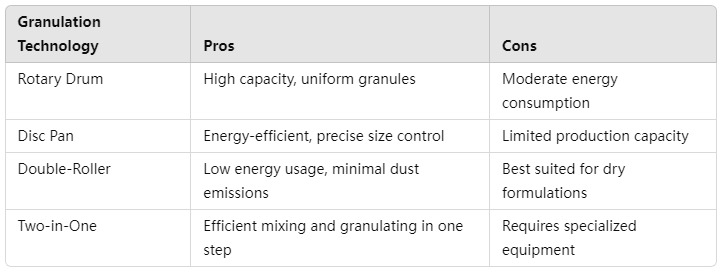
Selecting the appropriate granulation technology is a key factor in optimizing fertilizer production. Each granulation method offers distinct advantages, making it suitable for specific materials and production conditions. For example, rotary drum granulation stands out for large-scale operations due to its ability to handle high volumes and produce durable, spherical granules. On the other hand, disc granulators offer greater control over granule size with a compact, energy-efficient design, ideal for niche or smaller-scale fertilizer formulations.
For moisture-sensitive raw materials, double-roller granulation provides an effective dry granulation process, minimizing dust emissions while lowering energy consumption. This makes it an environmentally friendly choice for producing potassium-based fertilizers or other formulations that require low moisture levels. The two-in-one granulation technology pushes efficiency even further by integrating mixing and granulation, cutting down production steps and energy requirements, and ensuring a more uniform nutrient blend in each granule.
When deciding on a granulation method, manufacturers must carefully assess raw material properties, environmental requirements, and desired product characteristics. Additionally, energy consumption and production scale are critical considerations, as they directly impact operational costs and profitability. As the demand for high-quality fertilizers continues to grow, selecting advanced granulation technologies can help producers stay competitive while meeting environmental and market demands. Choosing the right granulation technology ensures optimal performance, product quality, and sustainable production processes for the future.



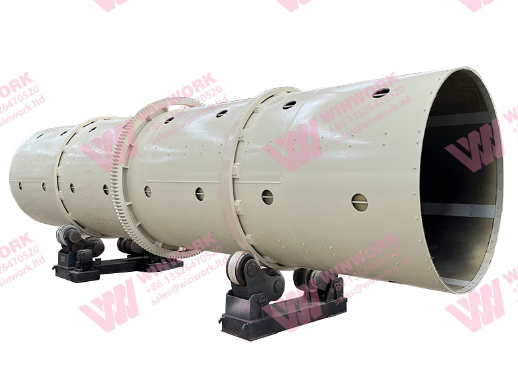

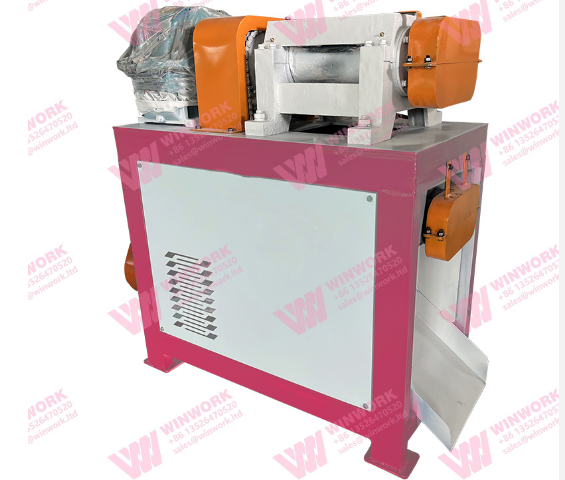

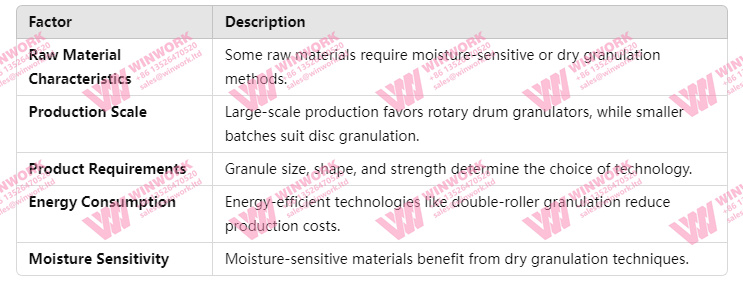

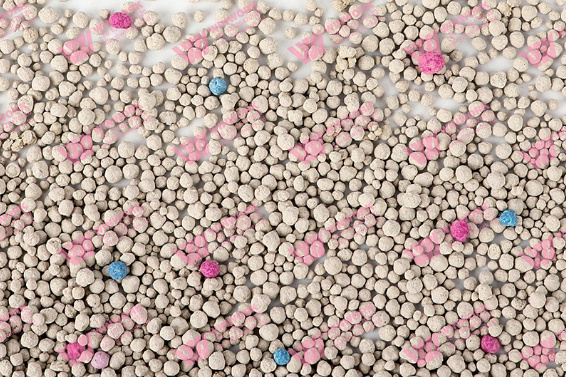
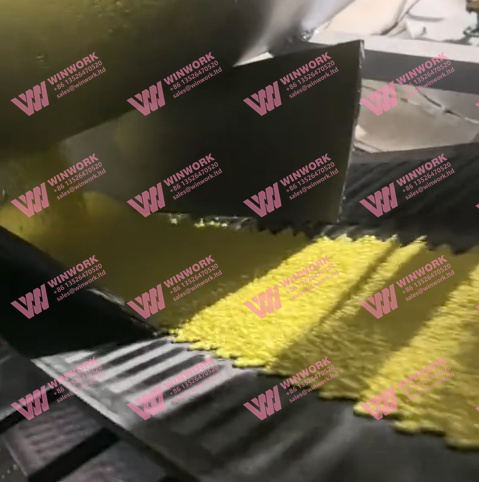
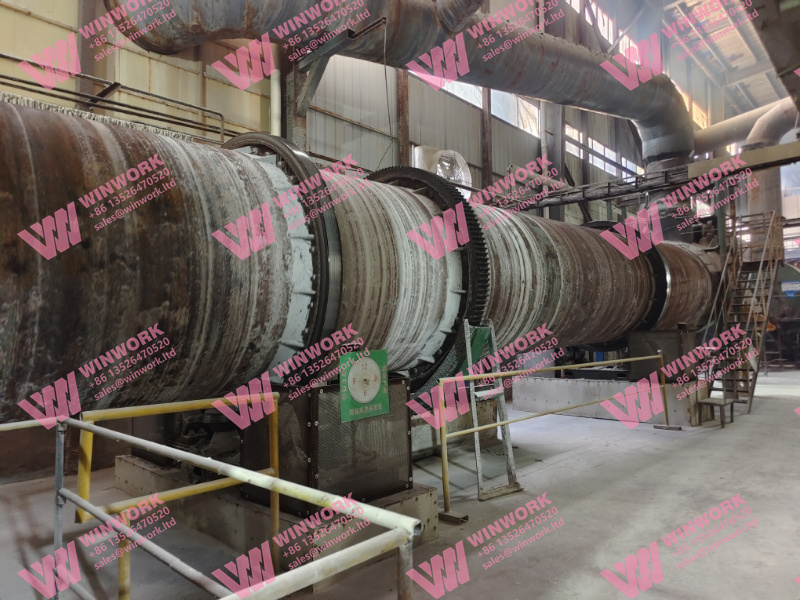
Get A Quote